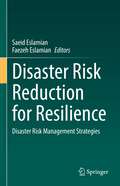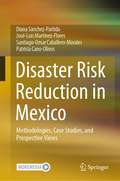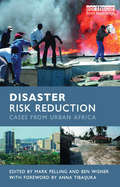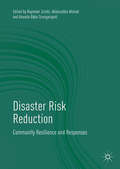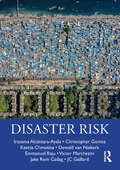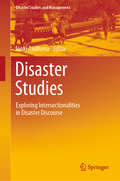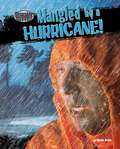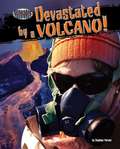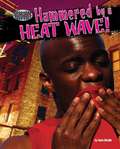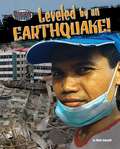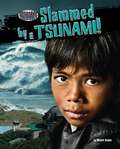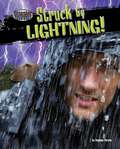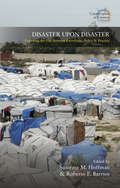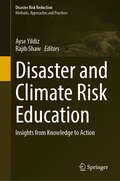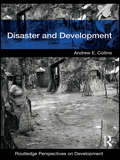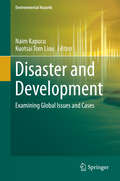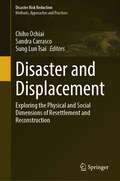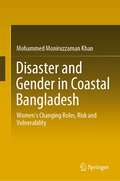- Table View
- List View
Disaster Risk Reduction for Resilience: Disaster Risk Management Strategies
by Saeid Eslamian Faezeh EslamianThis book is part of a six-volume series on Disaster Risk Reduction and Resilience. The series aims to fill in gaps in theory and practice in the Sendai Framework, and provides additional resources, methodologies and communication strategies to enhance the plan for action and targets proposed by the Sendai Framework. The series will appeal to a broad range of researchers, academics, students, policy makers and practitioners in engineering, environmental science and geography, geoscience, emergency management, finance, community adaptation, atmospheric science and information technology. This volume offers the international guidelines and global standards for resilient disaster risk reduction and lessons learned from disasters, particularly the COVID-19 and Cholera pandemics. A resilient health system and an effective disaster risk management Index are then suggested. The book further emphasizes urban resilience strategies with local authorities, adaptation strategies for urban heat at regional, city and local scales, and lessons from community-level interventions. Also addressed are coastal erosion, displacement and resettlement strategies. Land use planning and green infrastructure are suggested as tools for natural hazards reduction. Human security in times of climate change and urban heat at regional, city and local scales is discussed for an integrated action, with case studies based in Manila, Burkina Faso, Chad, Mauritania, Niger, Senegal, Nigeria, India, Spain, and Ghana. Structure design for cascading disasters resulting from mining and flooding is presented and sustainable smart city planning using spatial data is recommended.
Disaster Risk Reduction for Resilience: Disaster Socio-Hydrological Resilience and Sustainability
by Saeid Eslamian Faezeh EslamianThis book is part of a six-volume series on Disaster Risk Reduction and Resilience. The series aims to fill in gaps in theory and practice in the Sendai Framework, and provides additional resources, methodologies and communication strategies to enhance the plan for action and targets proposed by the Sendai Framework. The series will appeal to a broad range of researchers, academics, students, policy makers and practitioners in engineering, environmental science and geography, geoscience, emergency management, finance, community adaptation, atmospheric science and information technology.This volume discusses the implementation of socio-hydrological resilience measures to curb the impacts on vulnerable communities of hydrologic diasters such as coastal floods, drought, water scarcity, and thunderstorms. The book provides a framework for sustainable hydrology-community interactions to inform local communities about the best practices to achieve hydrological resilience, and to implement resilient water infrastructure. Hydrological influences on the resilience of a region are comprehensively surveyed, and a "green economy strategy" is described and recommended for achieving climatic and hydrological sustainability.
Disaster Risk Reduction for Resilience: Disaster and Social Aspects
by Saeid Eslamian Faezeh EslamianThis book is part of a six-volume series on Disaster Risk Reduction and Resilience. The series aims to fill in gaps in theory and practice in the Sendai Framework and provides additional resources, methodologies, and communication strategies to enhance the plan for action and targets proposed by the Sendai Framework. The series will appeal to a broad range of researchers, academics, students, policy makers, and practitioners in engineering, environmental science, geography, geoscience, emergency management, finance, community adaptation, atmospheric science and information technology.This volume provides a holistic approach to developing disaster risk reduction strategies and policies, exploring the most effective ways to integrate physical and social science aspects of hazard resilience to better inform local populations. This risk-based approach to community resilience development is used to craft a collaborative system for crisis management, and allows for the implementation of nationally determined contributions (NDCs) through social innovation and community engagement to enhance community emergency response support and preparedness. Readers will also learn about education of disaster risk reduction, human health risk assessment, gendered perspectives in disaster response, recovery, and disaster management legislation.
Disaster Risk Reduction in Mexico: Methodologies, Case Studies, and Prospective Views
by Diana Sánchez-Partida José-Luis Martínez-Flores Santiago-Omar Caballero-Morales Patricia Cano-OlivosThis book recognizes Mexico's effects and challenges in a natural disaster and offers empirical risk-reduction methods in critical cases. The proposals considered here include real and detailed analysis, a set of models, frameworks, strategies, and findings in the three stages of the disaster (before–during–after).This book:describes the methodology to find secure locations for the Regional Humanitarian Response Depot;offers recommendations for the sites and creation of an Export Logistics Cluster;shows how to use available technology and information to locate volunteers in the right spotsdescribes mathematical models to help to allocate procedure of resources for restoring the affected communityand proposes actions to create resilience in the country's main economic sectors, including agriculture and industry.The processes applied at recent disasters such as the 19S earthquake and their results are used as case studies, identifying possibilities for further improvement. The book also describes new trends for Mexico due to climate change and makes suggestions for mitigating future disasters. The proposals are also replicable to other highly populated societies with similar socio-economic structures. Finally, this book is the basis for generating more innovative recommendations by researchers, graduate students, academics, professionals, and practitioners to obtain better planning and better collaboration between all the humanitarian chain actors. This book intends to be of interest as a fundamental tool for decision-makers, governments, non-governmental organizations, and enterprises.
Disaster Risk Reduction: Cases from Urban Africa
by Ben Wisner Mark PellingPublished with ProVention Consortium, UNDP and UN-Habitat 'This excellent book is essential reading for those concerned with urban risk and its reduction in Africa, the most rapidly urbanizing region of the world.' Professor Jo Beall, Development Studies Institute, London School of Economics 'At last a book that recognizes the impacts of disasters on Africa's 350 million urban dwellers, including the many disasters that get overlooked and go unrecorded. But also a book that, through careful case studies, shows what creates disaster risk and what local measures can be taken to address it.' David Satterthwaite, International Institute for Environment and Development (IIED). 'This innovative volume combines the latest conceptualisations of urban disaster risk and vulnerability with case studies from across the African continent on how existing and innovative information can inform efforts to address the problems. Coverage ranges from the major catastrophes of news headlines to small, everyday disasters with which poor urban residents have to cope in their survival strategies. Written by international authorities and local specialists, this extremely useful book should find a place in the hands of academics and practitioners alike.' Professor David Simon, Department of Geography, Royal Holloway, University of London This is a one-of-a-kind book packed with original research and offering an innovative way of thinking about the reduction of risk in rapidly urbanizing cities across the globe. It is a must-have for professionals, researchers and policy makers. The book addresses four inter-related themes critical for urban risk reduction: environment; livehood; urban governance and the generation of urban risks. Its focus is on Africa, the most rapidly urbanizing world region, but it illustrates global processes. Part one reviews development, urbanization and disaster risk in Africa as a whole, identifies state-of-the-art practices and policies for building urban resilience and provides a tool kit for urban risk reduction. It also presents a powerful conceptual framework to analyse and compare disaster risk and resilience in different cities and communities. Part two presents detailed case studies from Algeria, Ghana, Senegal, Kenya, Tanzania and South Africa illustrating vulnerability to hazards ranging from earthquake to shack fire, environmental health hazards, traffic hazards and flooding. Part three looks to the future and outlines a vision for a safer urban Africa based on achieving gains in human security through inclusive governance and investment in the creative capacities of Africa's urban dwellers. With foreword by Anna Tibaijuka, Executive Director, UN-HABITAT
Disaster Risk Reduction: Community Resilience and Responses
by Bupinder Zutshi Akbaruddin Ahmad Ananda Babu SrungarapatiThis book discusses the interconnected, complex and emerging risks in today’s societies and deliberates on the various aspects of disaster risk reduction strategies especially through community resilience and responses. It consists of selected papers presented at the World Congress on Disaster Management, which focused on community resilience and responses towards disaster risk reduction based on South Asian experiences, and closely examines the coordinated research activities involving all stakeholders, especially the communities at risk. Further, it narrates the experiences of disaster risk-reduction in different communities that have policy implications for mitigation of future disaster risks in the societies affected by these types of disasters. Written from the social science perspective to disasters rather than an engineering approach, the book helps development and governance institutions to prioritize disasters as a problem of development rather than being parallel to it.
Disaster Risk Science: Science Plan And Case Studies Of Large-scale Disasters (IHDP/Future Earth-Integrated Risk Governance Project Series)
by Peijun ShiThis is the first English language book to systematically introduce basic theories, methods and applications of disaster risk science from the angle of different subjects including disaster science, emergency technology and risk management. Viewed from basic theories, disaster risk science consists of disaster system, formation mechanism and process, covering 3 chapters in this book. From the perspective of technical methods, disaster risk science includes measurement and assessment of disasters, mapping and zoning of disaster risk, covering 4 chapters in this book. From the angle of application practices, disaster risk science contains disaster management, emergency response and integrated disaster risk paradigm, covering 3 chapters in the book. The book can be a good reference for researchers, students, and practitioners in the field of disaster risk science and natural disaster risk management for more actively participating in and supporting the development of "disaster risk science".
Disaster Risk Science: Science Plan And Case Studies Of Large-scale Disasters (IHDP/Future Earth-Integrated Risk Governance Project Series)
by Peijun ShiThis is the first English language book to systematically introduce basic theories, methods and applications of disaster risk science from the angle of different subjects including disaster science, emergency technology and risk management. Viewed from basic theories, disaster risk science consists of disaster system, formation mechanism and process, covering 3 chapters in this book. From the perspective of technical methods, disaster risk science includes measurement and assessment of disasters, mapping and zoning of disaster risk, covering 4 chapters in this book. From the angle of application practices, disaster risk science contains disaster management, emergency response and integrated disaster risk paradigm, covering 3 chapters in the book. The book can be a good reference for researchers, students, and practitioners in the field of disaster risk science and natural disaster risk management for more actively participating in and supporting the development of "disaster risk science".
Disaster Risk and Management Under Climate Change (Disaster Resilience and Green Growth)
by Anil Kumar Gupta Akhilesh Gupta Pritha AcharyaThis contributed volume is focused on SDG 3, 6, 7 ,9, 11, 15, and it covers extensive knowledge on damage and loss contexts of climate change in a developing country. India’s vast landscape with its diversity of eco-geo-physiography, socio-cultural, and developmental settings, coupled with climate change and anthropogenic factors, makes it one of the most disaster-prone countries of the world and, thus, representing almost all the disasters and extreme events associated with climate change, variability, and weather phenomenon. Besides common hazards,such as heavy rainfall, floods, drought, cyclone and heat wave, secondary and composite disasters like forest fires and disease epidemics are also covered with case studies and examples. Cross-cutting aspects like infrastructure resilience, gender and social equity concerns, legal and assessment tools, and futuristic vision have been covered well in the book. Disaster risk reduction, preparedness, and resilience as central themes of adaptation to climate change are presented through policy discussions, tools, and strategic analysis of past and recent lessons. This book is of common interest to a wider range of readers across policyplanning, academia, research, and professional practitioners having interest in adaptation, resilience building and sustainability in developing countries of the world. Though it is primarily a reference book, it can also serve as a textbook for university courses and professional trainings in climate change adaptation, disaster management, sustainability and strategic management studies.
Disaster Risk, Resilient Agriculture and Livelihood: Methods and Applications
by Asraful AlamThis volume discusses important issues associated with agricultural disaster risk, resilient agriculture, and livelihood. It highlights the role of sustainable development goals in reducing the impact of climate change on agriculture. The contributions found in this volume discuss methodological and innovative resilience approaches to various natural hazards including flood, landslide, environmental challenges, strategies of disaster risk management, livelihood, ecosystem services, and agricultural sustainability. It explores the relationship between climatic change and agricultural transformation. While throwing light on the role of ecosystem services in disaster risk reduction, the book explores the impact of land degradation and change on growth of agricultural production and food production. The book will be useful for students and researchers of geography, environmental sciences, disaster management, and environmental geology. It will also be useful for geographers, environmentalists, hydrologists, geomorphologists, planners, and professionals working on related ideas.
Disaster Risk: International Lessons In Risk Reduction, Response And Recovery
by Irasema Alcántara-Ayala Ksenia Chmutina JC Gaillard Christopher Gomez Dewald van Niekerk Emmanuel Raju Victor Marchezini Jake Rom CadagThe text offers a comprehensive and unique perspective on disaster risk associated with natural hazards. It covers a wide range of topics, reflecting the most recent debates but also older and pioneering discussions in the academic field of disaster studies as well as in the policy and practical areas of disaster risk reduction (DRR). This book will be of particular interest to undergraduate students studying geography and environmental studies/science. It will also be of relevance to students/professionals from a wide range of social and physical science disciplines, including public health and public policy, sociology, anthropology, political science and geology.
Disaster Risks and Hazards: Practice for Resilience- Case for Zimbabwe (Advances in 21st Century Human Settlements)
by Innocent Chirisa Rosemary KasimbaThis book discusses disaster risks and hazards as well as measures to increase people’s resilience. The 21st Century has experienced a number of disasters that resulted in hampering socio-economic development, the loss of lives and property, hence they are a threat to sustainable development. Disaster risk management efforts and practices have failed to arrest the underlying drivers of increased global risk. No country is immune to disaster risk; thus, resilience has become a critical component of disaster management. It provides an opportunity to confront the social-ecological foundations of disasters. However, it has been vaguely conceptualised, and lacks a concrete approach to operationalization. Some developing countries are gradually coming to realise that preparedness, hazard mapping, prediction, risk and vulnerability assessment and planning are critical for increasing resilience and reducing losses following disasters. A paradigm shift is required from reactionary to proactive measures in disaster management as the later focuses more on increasing the resilience of the community. Zimbabwe’s disaster management policy of 1979 is in the process of review following Cyclone Idai in March 2019 and the Corona Virus 19 (COVID-19). Furthermore, the consequences of climate change disaster are being felt with across the world, particularly, developing countries, whose preparatory measures for such disasters are inadequate. Disasters have become inevitable and no country is every country is vulnerable to them. In the event of these disasters, the vulnerable people are at risk and are affected more as majority of them are not able to cope. In developed countries measures are in place to assist the vulnerable in the event that a disaster strikes. However, Zimbabwe, being a developing country is not able to deal with unpredictable disasters due to lack of resources, hence the need for it to adopt mitigatory and transformative measures to reduce the impact of any form of disasters.
Disaster Studies: Exploring Intersectionalities in Disaster Discourse (Disaster Studies and Management)
by Janki AndhariaThis book covers several dimensions of disaster studies as an emerging discipline. It is the inaugural book in the series ‘Disaster Studies and Management’ and deals with questions such as “Is disaster management a field of practice, a profession, or simply a new area of study?” Exploring intersectionalities, the book also examines areas of research that could help enhance the discourse on disaster management from policy and practice perspectives, revisiting conventional event-centric approaches, which are the basis for most writings on the subject. Several case studies and comparative analyses reflect a critical reading of research and practice concerning disasters and their management. The book offers valuable insights into various subjects including the challenge of establishing inter- and multi-disciplinary teams within the academia involved in disaster studies, and sociological and anthropological readings of post-disaster memoryscapes. Each of the contributors has an enduring interest in disaster studies, thus enriching the book immensely. This book will be of interest to all the students and scholars of disaster studies and disaster management, as well as to practitioners and policymakers.
Disaster Survivors Mangled By A Hurricane!
by Miriam AroninOn August 28, 2005, Trina Peters heard some alarming news -Hurricane Katrina was headed straight for her hometown of New Orleans, Louisiana. Though officials recommended evacuating the city, Trina and her daughter decided to stay in their home. However, the powerful hurricane caused their house to flood, and they had to climb up on their roof to stay above the rising water. Stranded on the roof in roaring winds and pouring rain, could Trina and her daughter survive the storm? Eyewitness accounts and incredible photos bring to life the experiences of ordinary people who faced catastrophic danger and lived to tell their stories. Kids will discover the causes and characteristics of hurricanes, and learn about efforts to rebuild and prepare for future storms. Safety tips show young readers what to do in case a hurricane strikes.
Disaster Survivors: Devastated by a VOLCANO!
by Stephen PersonOn June 25, 1997, a volcano on the Caribbean island of Montserrat erupted, spewing hot lava and ash. Linda Daley was washing clothes outside her home in the nearby city of Plymouth when she saw fiery clouds begin to shoot out of the volcano. With clouds of ash and poisonous gases speeding toward her, how would she survive? Eyewitness accounts and incredible photos bring to life the experiences of ordinary people who faced catastrophic danger and lived to tell their stories. Kids will discover the causes and characteristics of volcanoes, and learn about the scientific advances that now allow earlier warnings of possible eruptions to be issued. Safety tips show young readers what to do if they are ever near a volcanic eruption.
Disaster Survivors: Hammered By A Heat Wave!
by Laura DelalloIn July 1995, a scorching heat wave blasted Chicago with temperatures as high as 106° F (41° C) for five days straight. Such extreme weather can cause heat stroke and even death in vulnerable individuals; in fact, heat waves kill more people in the United States each year than any other kind of natural disaster. How would residents of Chicago survive the relentless heat? Eyewitness accounts and incredible photos bring to life the experiences of ordinary people who faced catastrophic danger -and lived to tell their stories. Kids will discover the causes and characteristics of heat waves and find out how hot weather can quickly turn deadly. Safety tips show young readers how to stay cool during a heat wave.
Disaster Survivors: Leveled By An Earthquake!
by Adam ReingoldOn May 12, 2008, a strong earthquake rocked Beichuan, China, destroying buildings and entire neighborhoods. When Beichuan's high school collapsed, 16-year-old Li Anning and her friends were trapped under the heavy rubble. Could the students survive until rescue workers arrived to save them? Eyewitness accounts and incredible photos bring to life the experiences of ordinary people who faced catastrophic danger -and lived to tell their stories. Kids will discover the causes and characteristics of earthquakes and learn about scientific advances that now help new buildings withstand the force of an earthquake. Safety tips show young readers what to do in case an earthquake occurs.
Disaster Survivors: Slammed By A Tsunami!
by Miriam AroninOn December 26, 2004, carpenter Ari Afrizal was helping build a house on the Indonesian island of Sumatra. Suddenly, he heard a loud whooshing sound and saw a wall of water heading directly toward him. The huge wave was a tsunami that destroyed the house he was working on and swept him out to sea. Alone in the ocean, Ari struggled to survive. Against all odds, would he live through this horrible ordeal? Eyewitness accounts and incredible photos bring to life the experiences of ordinary people who faced catastrophic danger -and lived to tell their stories. Kids will discover the causes and characteristics of tsunamis, and learn about scientific advances in warning systems. Safety tips show young readers what to do in case a tsunami occurs.
Disaster Survivors: Struck By Lightning!
by Stephen PersonOn July 26, 2003, mountain-climber Rod Liberal was nearing the summit of Grand Teton Mountain in Wyoming. As Rod clung to the side of a granite cliff, he saw dark clouds rolling toward him. Suddenly, there was a burst of light as a bolt of lightning struck his chest and blew him off the mountain. Attached to the cliff by a rope, he swung in the air thousands of feet above the ground. Would Rod be able to hold on until rescue rangers arrived to save him? Eyewitness accounts and incredible photos bring to life the experiences of ordinary people who faced catastrophic danger -and lived to tell their stories. Kids will discover the causes and characteristics of lightning strikes, and learn about scientific advances in weather forecasting and safety precautions. Safety tips show young readers what to do in case they're caught in a thunderstorm.
Disaster Upon Disaster: Exploring the Gap Between Knowledge, Policy and Practice (Catastrophes in Context #2)
by Roberto E. Barrios Susanna M. HoffmanA consistent problem that confronts disaster reduction is the disjunction between academic and expert knowledge and policies and practices of agencies mandated to deal with the concern. Although a great deal of knowledge has been acquired regarding many aspects of the gap, such as driving factors, risk construction, complexity of resettlement, and importance of peoples’ culture, very little has gotten into protocol and procedure. Disaster Upon Disaster illuminates the numerous disjunctions between the suppositions, realities, agendas, and executions in the field, goes on to detail contingencies, predicaments, old and new plights, and finally advances solutions and the matter of outcomes.
Disaster and Climate Risk Education: Insights from Knowledge to Action (Disaster Risk Reduction)
by Rajib Shaw Ayse YildizEducation serves as a cornerstone for gaining knowledge and taking initiative. However, despite efforts in disaster and climate risk education (DCRE), a gap often exists between awareness and meaningful action. To bridge this gap and promote a progression from awareness to empowerment, we offer the KIDA (Knowledge Interest Desire Action) framework. The foundation of this framework is a collaboration between schools, communities, and families, which calls for support from educational boards and local governments. Following international tragedies like the Turkey-Syria earthquake of 2023, as well as the ever-changing difficulties posed by climate change, DCRE has to be given priority immediately. Our book proposes a comprehensive strategy that includes governance, capacity building, education in schools and the community, and technology integration. Our insights, analyses, and practical policy suggestions are based on multidisciplinary research and worldwide case studies, with the goal of strengthening resilience and cultivating a generation committed to sustainability. This book provides a comprehensive exploration of DCRE. It aims to prepare individuals and communities to face the challenges of a changing world head-on by improving knowledge and promoting preparedness.
Disaster and Development
by Andrew E. CollinsDevelopment to a large extent determines the way in which hazards impact on people. Meanwhile the occurrence of disasters alters the scope of development. Whilst a notion of the association of disaster and development is as old as development studies itself, recent decades have produced an intensifying demand for a fuller understanding. Evidence of disaster and development progressing together has attracted increased institutional attention. This includes recognition, through global accords, of a need for disaster reduction in achieving Millennium Development Goals, and of sustainable development as central to disaster reduction. However, varied interpretations of this linkage, and accessible options for future human wellbeing, remain unconsolidated for most of humanity. This engaging and accessible text illuminates the complexity of the relationship between disaster and development. It opens with an assessment of the scope of contemporary disaster and development studies, highlighting the rationale for looking at the two issues as part of the same topic. The second and third chapters detail development perspectives of disaster, and the influence of disaster on development. The fourth chapter exemplifies how human health is both a cause and consequence of disaster and development and the following chapter illustrates some of the learning and planning processes in disaster and development oriented practice. Early warning, risk management, mitigation, response and recovery actions provide the focus for the fifth and sixth chapters. The final chapter indicates some of the likely future contribution and challenges of combined disaster and development approaches. With an emphasis on putting people at the centre of disaster and development, the book avoids confronting readers with ‘no hope’ representations, instead highlighting disaster reduction opportunities. This book is an essential introduction for students from multiple disciplines, whose subject area may variously engage with contemporary crises, and for many other people interested in finding about what is really meant by disaster reduction. They include students and practitioners of development, environment, sociology, economics, public health, anthropology, and emergency planning amongst others. It provides an entry point to a critical, yet diverse topic, backed up by student-friendly features, such as boxed case studies from the geographical areas of America to Africa and parts of Europe to parts of the East, summaries, discussion questions, suggested further reading and web site information.
Disaster and Development
by Naim Kapucu Kuotsai Tom LiouThis book offers a systematic, empirical examination of the concepts of disasters and sustainable economic development applied to many cases around the world. It presents comprehensive coverage of the complex and dynamic relationship between disaster and development, making a vital contribution to the literature on disaster management, disaster resilience and sustainable development. The book collects twenty-three chapters, examining theoretical issues and investigating practical cases on policy, governance, and lessons learned in dealing with different types of disasters (e. g. , earthquakes, floods and hurricanes) in twenty countries and communities around the world.
Disaster and Displacement: Exploring the Physical and Social Dimensions of Resettlement and Reconstruction (Disaster Risk Reduction)
by Chiho Ochiai Sandra Carrasco Sung Lun TsaiAcknowledging the multidimensional nature of disasters&’ impacts and subsequent recovery pathways as well as the central role of communities&’ agency, this book introduces and discusses the political, architectural and social dimensions of disaster-induced displacement and reconstruction in the long-term view. The impact of disasters on cities and housing worldwide is expected to be magnified by climate change, threatening to displace people temporarily or permanently, with cascading impacts at individual and collective levels. However, several issues are still unexplored, such as validating survivors&’ agency for their recovery. The book covers diverse international case studies using qualitative and quantitative research methods and a mix of both to document varied recovery pathways. The book is also enriched with studies addressing displacement in the context of armed conflict and other highly relevant circumstances affecting development. The discussions in this book provide insights for appropriate recovery initiatives, acknowledging the role of housing as the bedrock of durable and sustainable recovery and fostering the creation of safer building environments through the &“build back safer&” ethos for building resilient communities. The lessons from this book provide evidence to improve disaster planning and assistance, which is greatly pertinent for governments, humanitarian agencies, domestic and international NGOs, practitioners and academicians.
Disaster and Gender in Coastal Bangladesh: Women’s Changing Roles, Risk and Vulnerability
by Mohammed Moniruzzaman KhanThis volume explores the discourse of disaster and women in the existing social settings and state disaster-related affairs in coastal Bangladesh. It covers various issues ranging from disproportionate vulnerability, coping and adaptation mechanisms for women, limitations for promoting participation and involvement of women in the decision-making process both in family and community and changes in the role and responsibilities of women for reducing disaster risk and vulnerability. It contributes to the deconstruction of gender-based identity by addressing women's changing practices and roles in the coastal area in terms of the involvement of women with the development process, earning/income generation activities, decision-making process, access and entitlements to resources. This book presents the most current and inclusive circumstances of disaster and women of the coastal area in Bangladesh. The insights obtained through the eyes of a sociologist from a holistic perspective make this book different and unique. The book is of interest to researchers, academics, policymakers and professionals engaged in the social understanding of disaster studies, as well as to researchers and practitioners in interdisciplinary domains, including sociology, gender studies, social work, environmental studies, and development studies.
